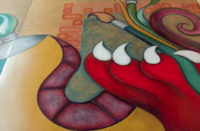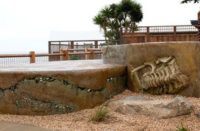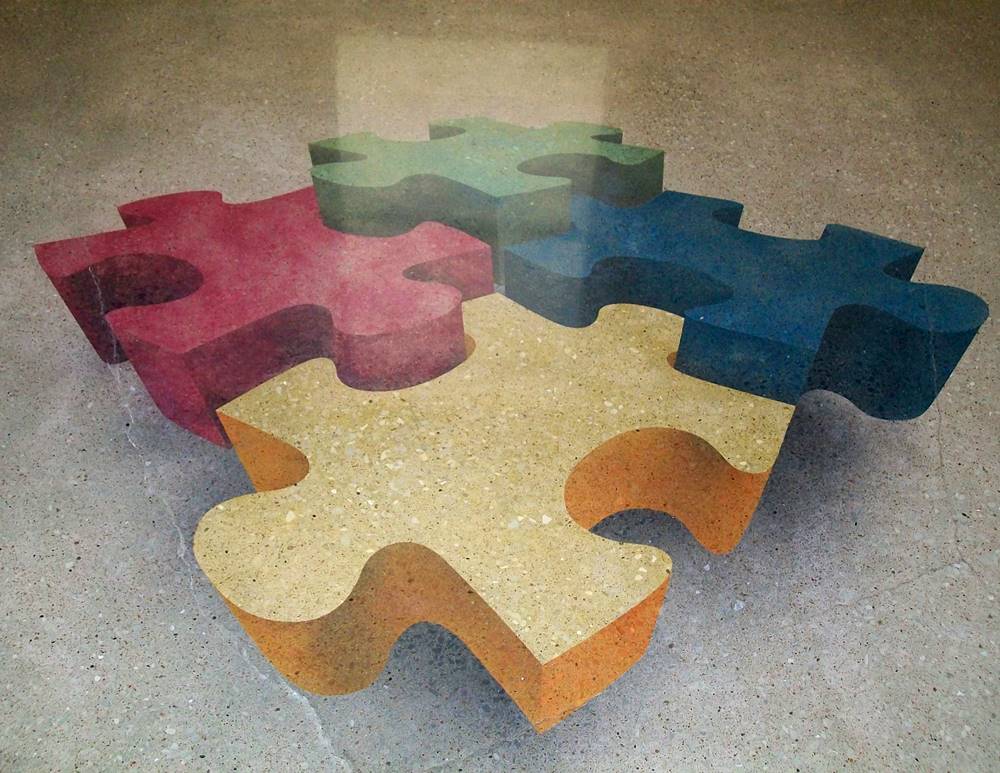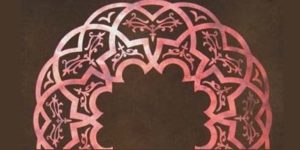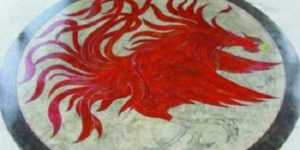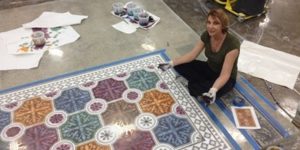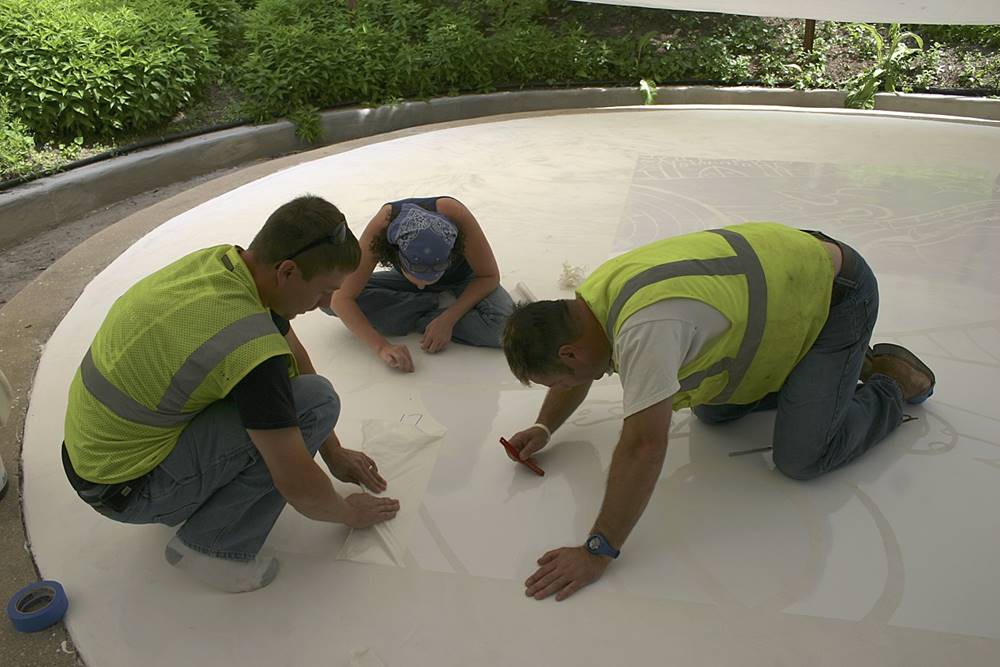
Complex and intricate designs can be applied to concrete surfaces very accurately using adhesive-backed vinyl stencils. They offer control, precision and, if needed, repeatability. Stenciling is a very old technique from the world of paint, but as it evolves in the concrete world, it’s becoming very modern, thanks to people like Rachel Knigge-Bruce.
A former graphic designer, Knigge-Bruce is a pioneer in the decorative concrete industry. Like modern painters’ stencils, her specially designed concrete stencils are cut out of sheets of vinyl. adhesive-backed vinyl stencils can be used with several different methods and coloring media, including dyes, microtoppings, epoxy, overlays, etching and acid stains. Through her company, Floormap Stencil Designs, she offers product, training, consulting and even installation.
Registration marks
Knigge-Bruce is one of the first people to incorporate registration marks in her stencils, similar to the ones used in four-color printing that allow multiple layers high precision alignment. Multilayered stencils enable a person with limited skill at painting or drawing to produce highly intricate, artistic works on concrete.
Also, to prevent color bleeding under the edge of the sheets, her concrete stencils (now available exclusively on the Concrete Decor Store) have adhesive on one side, so they can be temporarily sealed to the slab surface. This also makes it possible to block out isolated objects in a pattern.
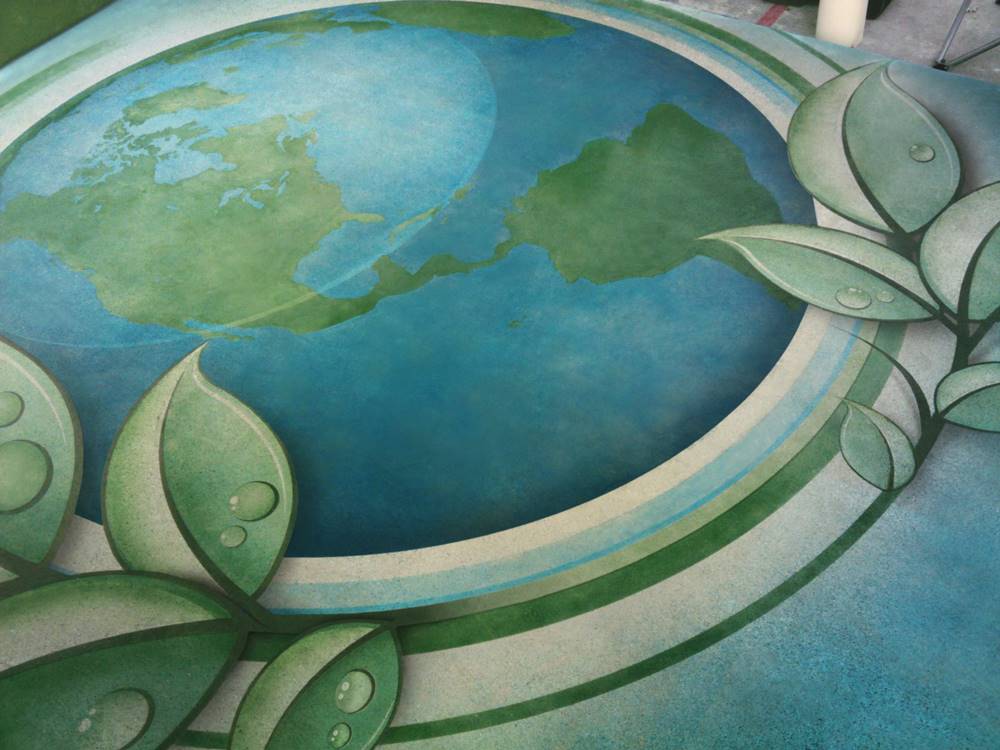
Stencils were previously available only with all the elements of the design on one stencil, explains Knigge-Bruce. “You would manually pull parts of the design, apply color and remask before continuing the same process to other areas. This really limited what you could do and was very labor-intensive. There were some multilayer stencil sets, but they were hard to align effectively.”
Her stencils can be put down on top of each other to make a more complex pattern. “The registration marks are built into the first layer of the design. After applying the color medium to the exposed surface area, you remove the layer — leaving the registration marks in place. All additional layers have a corresponding ‘window’ that allows the user to accurately align the next layer of the design.”
You can repeat this process with three, four, five, or more layers, building up the design with great accuracy.
The artist can execute very tight designs, laying colors right up against each other without gaps or overlaps.
|
|
Application techniques
Each stencil is built with three pieces: the adhesive vinyl, with the design cut in place, is sandwiched between backing paper on one side, to protect the adhesive, and transfer paper on the other side to hold all the pieces of the vinyl design in place until it is adhered to the surface area.
Once you place and align the layer where you want it, the user will stabilize the panel with blue painter’s tape. Then you remove the backing paper to expose the adhesive side of the vinyl. The stencil is then carefully applied onto the concrete using a specially designed squeegee made for vinyl application. The transfer paper is then stripped from the design, leaving just the vinyl mask and open areas that will receive the color.
Application is speedier than it sounds. According to Knigge-Bruce, stencil-making is the bigger time-consumer. “The Kansas City Chiefs logo, at 20 feet by 17 feet, was only two layers, but it took me about two days to make the stencil. It only took seven or eight hours to apply. That’s the beauty of the stencil system. It takes the guesswork out, so you can do something incredibly complex, incredibly cool, on a big scale, in a very timely manner.”
How to do 3-D
Three-dimensional illusions often involve multiple shades of a single color of translucent solvent-based dye. These use a unique stencil arrangement to achieve the goal.
Multilayer stencils make it possible to execute intricate work without either drawing or painting skills.
First, areas of each shade have numbers for identification. Then, Knigge-Bruce will start pulling all of the areas that take the darkest shade of the color. The remaining shades of that color are cut into the same layer, but are not removed at first.
After applying the darkest shade, the cut-outs for the next lighter shade are stripped out so the user can apply dye to single areas or small groups of areas according to the numerical order. The varying shades are achieved through different dye dilutions. Overspray onto the darker areas will only enhance them, so they don’t have to be remasked.

More tips
Knigge-Bruce advises using her methods on smooth surfaces: polished, ground or tightly troweled concrete, or self-leveling cementitious overlay. Microtoppings are very porous, so you have to be extra careful not to overapply colorant to prevent bleeding, she says. “Troweling microtopping material over the stencil to create embossed or reverse embossed designs can produce a very unique effect.”
Broom-finished slabs require the use of a different vinyl employing a much more aggressive adhesive. Likewise, if there are pockmarks or spalls in the concrete, it will be difficult to mask well. “Generally, I’ll use a blow-dryer to make the vinyl more pliable. Then I can press it down into the crevice and get good adhesion, preventing bleed.”
She cautions beginners to test a slab’s acceptance of colorant before laying down the stencil. “The stencil is a one-use item. If you apply colorant, pull up the stencil, and then find out the colorant didn’t penetrate, you’re stuck.”
On a fully polished slab, it is most common to apply the stencil after either the 400-grit or 800-grit polishing steps, she says.
The biggest mistake beginners make in stenciling, she observes, is rushing the stencil application. “Be patient. If you don’t apply the material correctly, you’ll get creases and folds, and then the registration of other layers won’t line up. You have to lay the vinyl down absolutely flat. Take the time to get it right.”
Adhesive-backed Stencil Patterns Available
Offered by Concrete Decor Store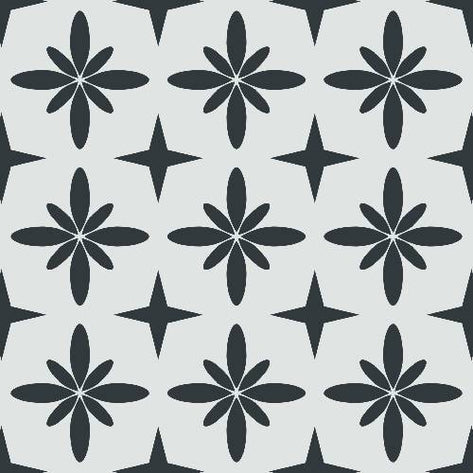 Floral Star Tile Pattern - Adhesive-Backed Stencil
Floral Star Tile Pattern - Adhesive-Backed Stencil
by FloorMaps Inc.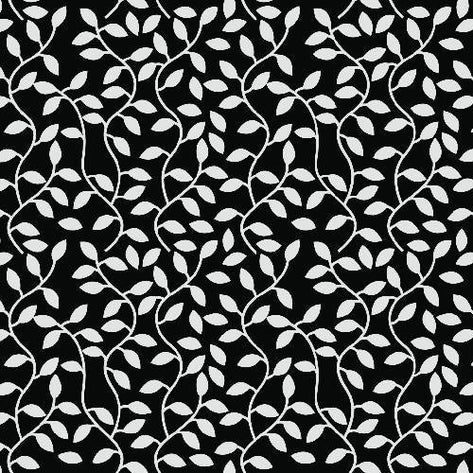 Vine Leaf Pattern - Adhesive-Backed Stencil
Vine Leaf Pattern - Adhesive-Backed Stencil
by FloorMaps Inc. Geometric Line Pattern - Adhesive-Backed Stencil
Geometric Line Pattern - Adhesive-Backed Stencil
by FloorMaps Inc.

